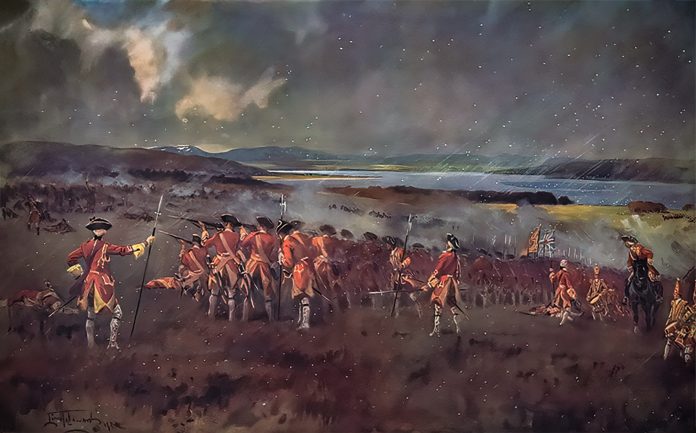While the Duke of Cumberland’s army was encamped at Aberdeen and Strathbogie in March and early April 1746, Cumberland and Major-General Humphrey Bland, the British Army’s senior tactician, ensured that the infantry battalions were sufficiently trained for the upcoming encounter with the Jacobite army, specifically on how to deal with the Highland charge.
The British Army were expert in delivering devastating firepower on an enemy force through the platoon firing system, which ensured a continual rolling fire of musketry from the infantry battalions.1 Each battalion was deployed 3 ranks deep and divided into firing platoons which would open fire at roughly 60 yards by alternate firings, either individually or in grouped “firings” beginning on the flanks and ending in the centre. After the final platoon had fired, the sequence would start over again. The front rank of the battalion would kneel to fire while the second rank fired between the front rank, and the third rank fired over the heads of the first rank.

In A Treatise of Military Discipline, Major-General Bland outlined that a battalion was typically divided into 12, 15 or 18 platoons, which were grouped into three “firings”.2 The number of platoons would depend on the strength of the battalion, the tactical situation and on the particular firings the commanding officer intended to perform. All of the platoons would be of equal strength, numbering no less than 30 men and no more than 48 to ensure sufficient firepower and command and control in the heat of battle. The grenadier company, split into two platoons and positioned on the flanks of the battalion, usually held its fire in reserve in case of emergencies.
To deal with the Highland charge, Cumberland and Bland introduced a modified platoon firing system which was designed to inflict the maximum damage on an enemy that was moving forward at speed and was similar to how Bland advised infantry battalions on dealing with a cavalry attack.3 Each battalion was divided into 18 platoons, which were to open fire at no more than 30 yards, starting from the right and left to the centre. The front rank and the grenadiers were to hold their fire until the Jacobites were at point-blank range before unleashing a devastating volley.
This new method was first mentioned on 2 April 1746, when Cumberland ordered that the Royal Scots Fusiliers were “to be out in the Park tomorrow at 11 o’clock there to practice the motions of alternate firings by platoons from ye right and left to ye centre reserving fire of ye front rank and Grenadiers.”4

Cumberland would not rely on firepower alone to defeat the Highland charge, and he instructed his infantry to undergo rigorous bayonet training to give his soldiers the ability and confidence to stand and deal with any Jacobites that reached his lines. Contrary to popular belief, he did not introduce a new bayonet method but rather had his soldiers perform the standard bayonet drill, which involved the soldiers presenting a hedge of bayonets thrust forward at chest height. An effective defence, as the bayonet offered a longer reach than the Highland broadsword.
The soldiers’ confidence in their training and their capacity to stand and avert the panic experienced at Prestonpans, and to a lesser degree at Falkirk, was crucial for success. The Highland charge was as much psychological as it was physical, aimed at instilling fear in the enemy, prompting them to break and run, whereupon they would be cut down by the highlanders’ blades. Should the opposing force choose to stand and fight rather than retreat, the charge would very likely fail.
Cumberland’s army marched out from Aberdeen on 8 April 1746 and on the 16th met and defeated Charles Edward Stuart’s Jacobite army in battle on Culloden Moor outside Inverness. There is evidence to suggest that the modified platoon firing method was used at the battle. An account of the battle stated that Cumberland’s battalions fired on the advancing Jacobites “according to Orders, viz. the 2d and 3d Rank as they were within 30 Yards, and the 1st just as they were at the Muzzles of their Guns.”5
Another eyewitness to the battle wrote: “They broke in upon Barrel’s Regiment, and the left of Munro’s who had given their Fire, the second and third Rank as they were within 30 yards, and the first received them with their Fire upon the points of their Bayonets”.6
Notes:
- The platoon firing system had been introduced to British battalions by Major-General Hugh Mackay in 1689 and was first employed against the Jacobite Highlanders at the battle of Killiecrankie that year. ↩︎
- Humphrey Bland, A Treatise of Military Discipline, (London 1743), p 65. ↩︎
- Ibid, p 94. ↩︎
- Nottingham University, Hallward Library, Galway Collection, GA 12835, quoted in: David Blackmore’s Destructive and Formidable: British Infantry Firepower 1642–1765, p. 111. ↩︎
- The History of the Rebellion 1745, and 1746, (London 1748), p 216. ↩︎
- Andrew Henderson, The History of the Rebellion 1745 and 1746, (London 1753), p 327. ↩︎
Cite this article: Ritchie, N. S. (2 April 2025). Duke of Cumberland’s new platoon firing drill. Jacobite Wars. https://www.jacobitewars.com/articles/duke-of-cumberlands-new-platoon-firing-drill/

